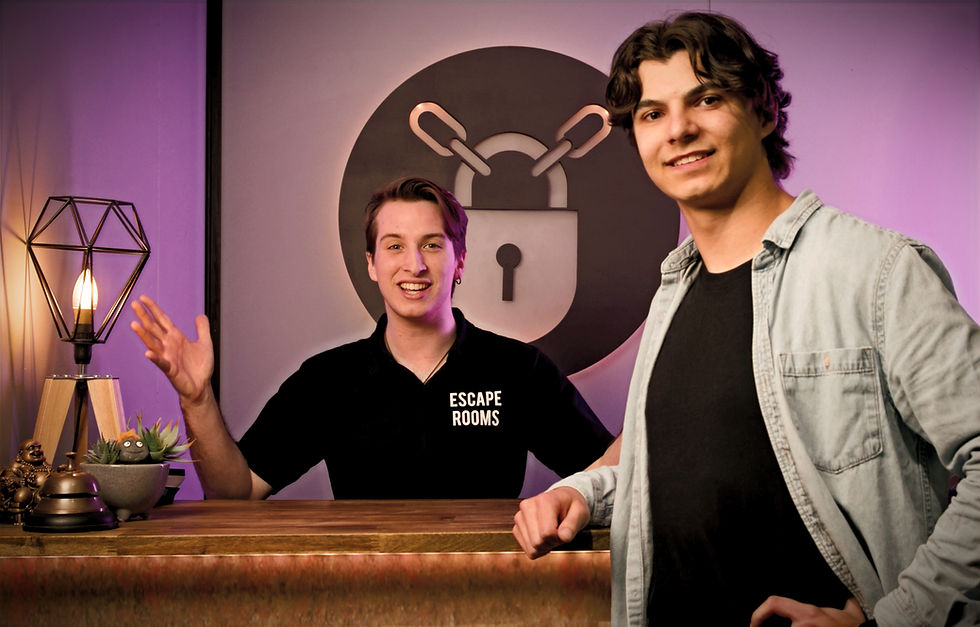Let's talk a little about Horror Escape Rooms
- Escape Artist

- May 22
- 3 min read
Updated: Jul 31
Escape rooms attract enthusiastic participants who love challenges. These engaging environments allow players to immerse themselves in a storyline while solving puzzles under the pressure of a ticking clock. Yet, many potential participants find themselves wondering: Are these experiences truly frightening, or are they more about thrills?
Not all escape rooms are designed to be scary; many offer a variety of themes that focus on puzzles, adventure, and teamwork rather than fear. While some rooms, like "The Doll" at Escape Rooms Takapuna, embrace a horror theme, there are plenty of options available that provide a fun and engaging experience without the fright factor. These rooms can cater to all preferences, ensuring that everyone can enjoy the thrill of solving mysteries and escaping within a set time limit.
The Thrill of the Challenge
Escape rooms aren’t solely about fear; they mainly captivate participants with their intellectual challenges. The thrill arises from solving puzzles and completing tasks while racing against the clock. Players need to think critically and collaborate to escape before time runs out.
Consider this: a survey conducted by the Escape Room Industry found that 75% of players said that the challenge of problem-solving was the most enjoyable aspect of their escape room experience. This mental engagement triggers an adrenaline rush, often leading to a sense of accomplishment that many find addictive.
While you may navigate through dark hallways, puzzle over clues, or strategise with your team, the real excitement comes from the collective effort and camaraderie. Celebrating milestones, no matter how small, enriches the experience and transforms it into something more significant.
Horror Escape Room at Escape Rooms Takapuna
The environment created in escape rooms plays an essential role in shaping participants' experiences—especially in horror-themed scenarios. Designers typically use psychological techniques such as dim lighting, eerie soundscapes, and unsettling decor to build tension.

For example, the “Escape Rooms Takapuna Horror Theme” is famous for its chilling atmosphere that stimulates our primal instincts. While these elements can create anxious moments and adrenaline spikes, it doesn’t necessarily mean everyone feels terror.
Focusing on intricate details—a creaky door, distant whispers—can elevate immersion. However, your response may differ significantly from someone else's. What feels like excitement for one might feel terrifying for another.
The Horror Element
Horror escape rooms leverage spine-chilling themes to heighten the experience. "The Doll" escape room epitomises how horror narratives can amplify excitement while still being comical for some. Participants often find themselves solving puzzles that involve creepy dolls and ghostly figures, contributing to an intense atmosphere.
Yet, this type of fear experience contrasts with more traditional horror media. Instead of passively consuming horror through a movie, players actively engage with their surroundings. They influence the outcome by solving clues, which often dilutes intense fear, leading to exhilaration instead.
This unique dynamic allows players to experience fear while managing their own emotions. As a result, many leave feeling thrilled instead of terrified or vice versa
Individual Reactions to Fear
An intriguing aspect of escape rooms is how differently each participant reacts to fear. Some players thrive in tense situations, while others might feel overwhelmed.
For instance, a study revealed that 60% of players reported that horror elements enhanced their enjoyment, while 30% admitted they would rather skip those aspects altogether. Recognising one's comfort zone is crucial when choosing horror-themed escape rooms.
Communicating feelings with your fellow players can ease tension and enhance enjoyment. It’s essential to create an environment where everyone feels comfortable expressing their emotions, which makes for a more memorable experience.
Creating Unforgettable Memories
Regardless of whether you find escape rooms scary or thrilling, they create unforgettable experiences that foster connections. These activities promote teamwork and creativity, differentiating them from standard entertainment.
After completing an escape room, conversations often revolve around memorable puzzles and unexpected team tactics. The bond formed during shared fear and excitement can lead to stories that last for years.
Stats show that 80% of escape room participants report wanting to revisit or recommend the experience to others. This signifies the lasting impact of the moments shared under pressure, forming a community among enthusiasts.
Wrapping Up
In summary, escape rooms offer a fascinating mixture of excitement, mental challenges, and sometimes, a hint of fear. While many horror-themed rooms incorporate elements designed to send shivers down your spine—like the immersive experience found in rooms such as "The Doll"—the core of these adventures resides in problem-solving and teamwork.
Your escape room experience may lean towards thrilling or unsettling based on personal preferences and how you handle fear. Ultimately, these interactive adventures are a fantastic way to connect with friends or family, craft unforgettable memories, and maybe even confront personal fears in a fun environment.
So, the next time you consider an escape room adventure, think about your appetite for thrills versus chills—because in this world, excitement is guaranteed, even if fear is not.





Comments